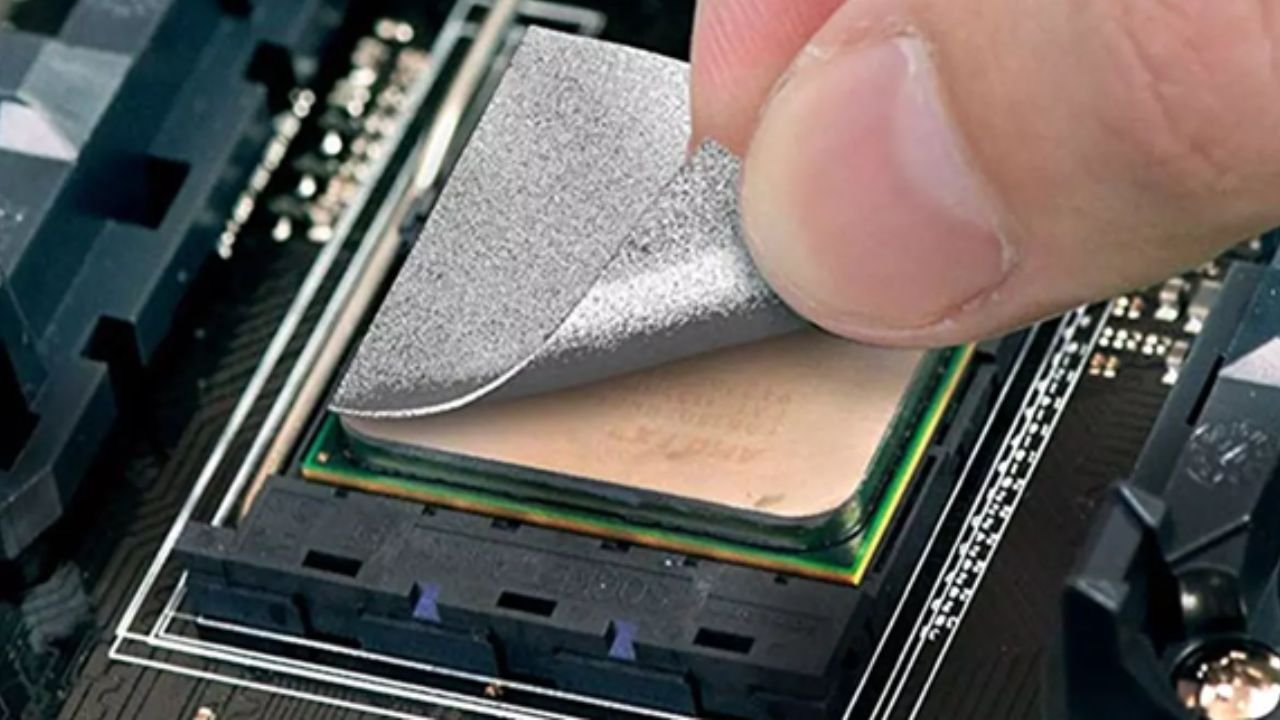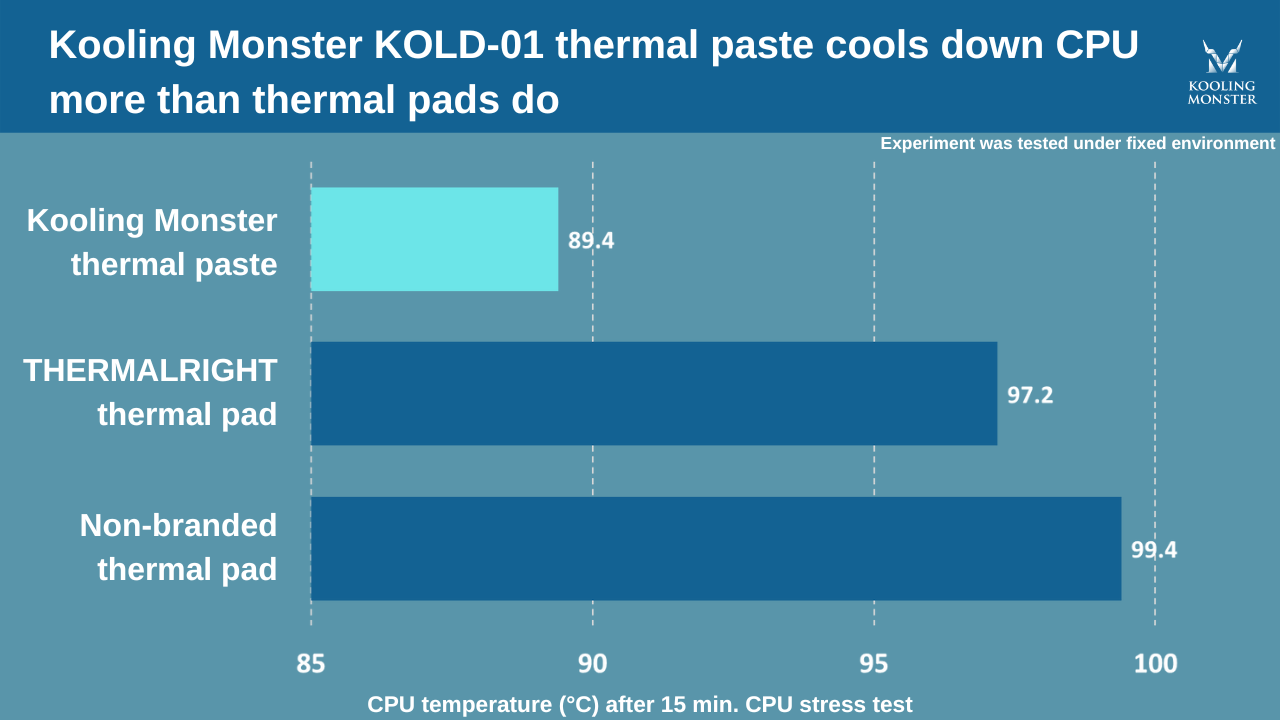CPU Thermal Paste vs Thermal Pad: Which Is the Best?
It’s tried and tested that a good-quality thermal paste is essential for a computer to perform well. Even then, many people keep on looking for “alternatives” to save a few bucks.
While most of the alternatives, like toothpaste and butter, are utter trash as a thermal paste replacement, there are a few that could actually work — and thermal pads are one of those. But how does a thermal pad compare to a top-tier thermal paste? How does it perform? Should you use it?
Keep reading and you will find out everything you need to know.
Case study summary: Thermal paste is the BEST
To find out which one performs more effectively, Kooling Monster conducted a test to measure the thermal performance of each.
Based on our results, we concluded that a thermal paste can drastically improve the thermal performance of a computer than a thermal pad. The summary of the test can be observed below.
As you can see, Kooling Monster KOLD-01 thermal paste was able to keep the CPU much cooler when compared to a branded thermal pad. The improvement was night and day. The difference of 8 degrees Celsius is a massive improvement in terms of the CPU’s thermal performance.
Furthermore, when we used a local, non-branded thermal pad, the performance was even worse.
How did we measure thermal performance?
For this test, we used a computer with the following specifications.
CPU: Intel Core i3-10105F
Motherboard: Asus H510M-E
Cooler: Air Cooling Golden Field
Memory: ADATA 8GB
We used AIDA 64 to perform the stress test and HWInfo to record the thermals. The room temperature of the controlled environment was 28 degrees Celsius, and we used the buttered toast method to apply thermal paste to the CPU.
For this test, we purposefully picked a PC that didn’t have a powerful cooling system. That’s because we wanted to let the thermal paste/pad do the heavy lifting, so we can measure their performance more effectively.
Stress test results
The computer with KOLD-01 thermal paste was running cooler, even before the stress test began.
However, when we initiated the stress test, the computer with the non-branded thermal pad immediately rose up to around 99 degrees Celcius. At the end of the test, it was burning hot at 99.4 degrees Celcius.
THERMALRIGHT thermal pad did comparatively better in the early seconds of the stress test. However, it proceeded to go up to 97.2 degrees Celcius by the end of the stress test. Last but not least, KOLD-01 displayed the best performance out of the 3. It was the slowest to get hot when we initialized the stress test and only went up to 89.4 degrees Celcius.
What are thermal paste and thermal pad?
Now, you must be wondering what’s the physical and technical difference between the two products.
Well, we’ve got you covered.
Thermal paste
Thermal paste is the default thermal management solution used between CPU/GPU and heatsink.
As the name suggests, it has a paste-like structure, which serves well to fill in all the tiny air gaps between the CPU and heatsink. Furthermore, thermal paste has the absolute best thermal conduction performance among all the alternatives you could find. (Learn more about What Is Thermal Paste?)
Thermal pad
A thermal pad is a solid, mat-like material that you have to stick between your CPU/GPU and the heatsink.
However, we recommend you use a thermal paste instead — that’s because a pad’s thermal performance isn’t as good as a thermal paste. As it’s a solid mat, it cannot fill in all the air gaps between the CPU/GPU and heatsink. Plus, it comes in different rectangular sizes, and you will need to hunt for the exact size that matches your CPU/GPU size — which is, to be honest, quite cumbersome. (Learn more about What Are Other Thermal Paste Alternatives?)
Can I use a thermal pad instead of paste on CPU or GPU?
Technically, you can. But do we recommend it? No.
As you’ve learned from our case study, the thermal performance of a thermal paste is much, much better than a thermal pad. So, you must always opt for a good-quality thermal paste.
However, there are some exceptional use cases where you would be fine with a thermal pad, too. For instance, if you only use your computer for light web browsing or essay writing, your computer will never heat up anyway. So, in such a case, a thermal pad might suffice.
Even then, we recommend you get a thermal paste, as this tiny investment can go a long way.
Even if you don’t do anything intensive on your computer, it might do heavy tasks in the background itself. For example, it may download and install updates in the background every couple of weeks, and that’s an intensive task. When it happens, your computer might overheat.
What is a thermal pad used for?
You must be wondering, “If the thermal paste is so much better, why do thermal pads even exist?” — that’s a great question.
Well, there are some other computer components that require heat dissipation. For instance, they’re used in Printed Circuit Boards (PCBs) to thermally solder the boards from other components. A pad is more useful in such tiny spaces because it’s easier to apply, and is usually less messy.
All you have to do is peel off the thermal pad and place it on the surface, and you’re good to go. Due to this ease of application, thermal pads are more suited for lesser-known computer components that require heat dissipation but don’t need the full thermal performance of a thermal paste.
The bottom line
Based on what we found during our case study, a thermal paste is a much better option than a thermal pad, in most cases.
While a thermal pad could be useful if you don’t do anything intensive on your computer, we still recommend you to go for a thermal paste; it just makes more sense in the long run.
FAQ
What impact does the use of thermal paste vs thermal pad have on CPU performance?
Thermal paste significantly outperforms thermal pads in maintaining CPU thermal efficiency. During a stress test, Kooling Monster KOLD-01 thermal paste maintained a lower CPU temperature by around 8 degrees Celsius compared to a branded thermal pad, ensuring better CPU performance.
In what specific scenarios might a thermal pad be a suitable choice?
While thermal pads aren't recommended for heavy-duty tasks, they might suffice for light computer usage such as web browsing or essay writing. Also, due to their ease of application, they are used in Printed Circuit Boards (PCBs) where full thermal performance isn't necessary.
What makes thermal paste more effective for heat dissipation than a thermal pad?
Thermal paste is superior due to its better thermal conduction performance. Its paste-like structure can fill in all the tiny air gaps between the CPU and heatsink, enhancing heat transfer. In contrast, thermal pads, being solid, cannot fill all the air gaps, thus reducing efficiency.
How does the physical structure of thermal paste and thermal pad affect their heat dissipation performance?
Thermal paste, being a paste-like material, can fill in microscopic imperfections between the CPU and heatsink, enabling better heat transfer. On the other hand, thermal pads, being solid mats, can't fill all air gaps and thus provide inferior heat dissipation. They are also cumbersome to fit due to their predefined sizes.





